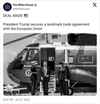Tariffs
U.S. and EU Strike 15% Tariff Deal, Critics Warn of Heavy Costs for Europe
The U.S. and EU struck a deal to impose 15% tariffs on most goods.
The United States and European Union narrowly avoided a trade war over the weekend, agreeing to a framework deal that imposes a 15% tariff on most EU goods. While hailed as a diplomatic breakthrough, the agreement has sparked backlash from European business leaders and officials who argue it is unbalanced and damaging to exporters.
Key Details of the Deal
- Tariff Terms: 15% tariffs across most EU goods — half of Trump’s threatened 30% but more than triple the current 4.8% average.
- Major EU Commitments:
- $600 billion in EU investments in the U.S.
- Substantial increases in U.S. energy and defense purchases.
- Industries Impacted: Cars, pharmaceuticals, and semiconductors face new costs. Steel and aluminum remain at 50% tariffs, though future quotas are under discussion.
- Exemptions: Aircraft, some chemicals, certain agricultural goods, and semiconductor equipment.
“We have a trade deal between the two largest economies in the world, and it’s a big deal. It will bring stability. It will bring predictability.”
— Ursula von der Leyen, European Commission President
European Pushback
Despite avoiding Trump’s threatened 30% tariff, European leaders and business groups warn the deal heavily favors the U.S.
- German Business Concerns:
- The BDI federation called the deal a source of “considerable negative repercussions.”
- The VCI chemical association said the rates were “too high.”
- Auto industry leader Hildegard Müller warned of “huge costs” for German carmakers already in transition.
- French Response:
- France’s Minister for Europe, Benjamin Haddad, called the deal “temporary stability … but unbalanced.”
- Financial Sector Reaction:
- Berenberg Bank said the agreement was a “victory for Trump” and warned the U.S. “gets away with a substantial increase” while Europe shoulders the costs.
- UniCredit echoed the concerns, calling the outcome “heavily asymmetrical.”
“The extra U.S. tariffs will hurt both the U.S. and the EU. For Europe, the damage is mostly frontloaded.”
— Holger Schmieding, Chief Economist, Berenberg Bank
The Political Calculus
The deal is being touted by Trump as a major win, mirroring a similar framework reached with Japan earlier this month. EU officials, however, admit the outcome is far from ideal.
- Von der Leyen conceded, “Fifteen percent is not to be underestimated, but it is the best we could get.”
- Trump emphasized that steel tariffs will “stay the way they are” at 50%, though von der Leyen later suggested a quota system may be possible.
- Talks continue on sensitive sectors like spirits and pharmaceuticals.
Source: Reuters | The Guardian
Sign up for FreightCaviar
The only newsletter you need for freight broker news & entertainment.
No spam. Unsubscribe anytime.
